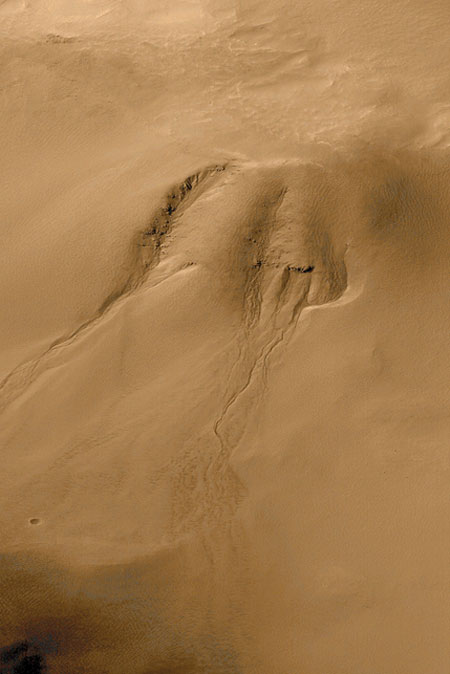Mars Gullies Likely Formed By Underground Aquifers

The revelation in 2000 that gully features have been spotted on Mars sparked numerous ideas as to how the geological features were formed.
A study team is analyzing images of gullies captured by the Mars Global Surveyor's (MGS) Mars Orbiter Camera, adding in laser altimeter and spectrometer data taken by the same spacecraft. They believe the gullies are the products of shallow and deep aquifers in Mars' subsurface.
Aquifers are defined as an underground geological formation or group of formations that contain water -- a source of ground water for wells and springs.
If these pockets of water are indeed subsurface on Mars, they could act as a "user friendly" habitat for Martian microbes. Furthermore, these underground niches could be tapped by future Mars expeditionary crews armed with drilling gear to reach the reservoirs of water.
Northern and southern hemisphere
Mars gully work is being done by Jennifer Heldmann, a space scientist at NASA's Ames Research Center near San Francisco, California and Michael Mellon of the University of Colorado's Laboratory for Atmospheric and Space Physics in Boulder, Colorado.
Their early findings, "Observations of Martian Gullies and Constraints on Potential Formation Mechanisms", were based on a northern hemisphere survey of Mars and presented in the April issue of Icarus, a planetary science journal. Work is now underway on Mars' southern hemisphere.
Breaking space news, the latest updates on rocket launches, skywatching events and more!
"Preliminary work looks promising and the southern data is supporting the trends observed in the north," Heldmann told SPACE.com. Furthermore, soon to be published work supports the idea that the Martian gullies are being fashioned by relatively pure liquid water under current climatic conditions on the planet.
Most plausible theories
No model yet proposed explains all observed gully features, the scientists note. However, their data points them toward gully creation due to subsurface water. Carbon dioxide, melting ground ice, dry landslide, and snowmelt models, they explain, "inadequately conform to the MGS observations and are the least likely mechanisms of gully formation proposed to date."
"Although some discrepancies still exist between prediction and observation, the shallow and deep aquifer models remain as the most plausible theories," Heldmann and Mellon report.
The research duo notes that future Mars orbital cameras -- such as the High Resolution Imaging Science Experiment (HiRISE) aboard NASA's Mars Reconnaissance Orbiter (MRO) in 2005 -- will be very valuable for determining the ultimate mechanism(s) of formation for the gullies.
Ground penetrating radar carried by Europe's Mars Express now in orbit around the red planet and onboard MRO to be launched next year will also help in the ongoing detective work concerning the gullies.
"With persistent study and the analysis of additional data, we are beginning to unravel the mystery of the Martian gully systems," the researchers conclude.
Liquid paydirt
Meanwhile, the prospect that water is accessible at shallow depth on Mars is viewed as liquid paydirt by Carol Stoker, a research scientist at NASA's Ames Research Center in California's Silicon Valley.
Stoker is principal investigator of a three-year project tagged the Mars Analog Research and Technology Experiment, or MARTE for short.
MARTE is being carried out at a project site near Spain's Rio Tinto River. The team is using drilling and scientific instruments with an eye toward using the same techniques and technologies in future Mars sorties - be they by robots or humans.
MARTE involves scientists and engineers from NASA, U.S. universities and the Spanish Centro De Astrobiologa (Center for Astrobiology). They are keen on showing how robot systems could look for life below Mars' surface.
Pump up the volume
Drilling to extract liquid water on Mars is feasible and worth the investment, Stoker reported last week at Space Resources Roundtable VI, held at the Colorado School of Mines in Golden, Colorado.
The discovery of hundreds of recent water-carved gullies on Mars indicates liquid water can be found at various depths in a wide array of locations, Stoker said. Drilling to obtain liquid water via pumping is feasible and could lower the cost and the return of Mars exploration more than any other resource extraction and utilization technology on the horizon, she added.
Stoker advocated that NASA adopt a strategy of using liquid water on Mars as a resource, as well as boost investments in robotic drills for the red planet. Doing so would help bring together the science of looking for life on Mars with NASA's new human space exploration goals, she said.
"You can merge the goals of science and exploration," Stoker advised, and subsurface water on Mars is the place they merge.
Cornerstone architecture
A system of modular, reconfigurable, autonomous and human-tended deep drilling technologies should be developed for use initially on Mars precursor missions and later for subsequent piloted missions that are less mass and power constrained, Stoker reported at the Space Resources Roundtable.
"Early testing on the Moon could be used to establish the viability of this technology so that it can be a cornerstone architecture element of Mars exploration, as well as a tool for resource exploration and science," Stoker explained.
An end-to-end simulation of a Mars drilling mission will be held in Rio Tinto next year, Stoker said.

Leonard David is an award-winning space journalist who has been reporting on space activities for more than 50 years. Currently writing as Space.com's Space Insider Columnist among his other projects, Leonard has authored numerous books on space exploration, Mars missions and more, with his latest being "Moon Rush: The New Space Race" published in 2019 by National Geographic. He also wrote "Mars: Our Future on the Red Planet" released in 2016 by National Geographic. Leonard has served as a correspondent for SpaceNews, Scientific American and Aerospace America for the AIAA. He has received many awards, including the first Ordway Award for Sustained Excellence in Spaceflight History in 2015 at the AAS Wernher von Braun Memorial Symposium. You can find out Leonard's latest project at his website and on Twitter.
